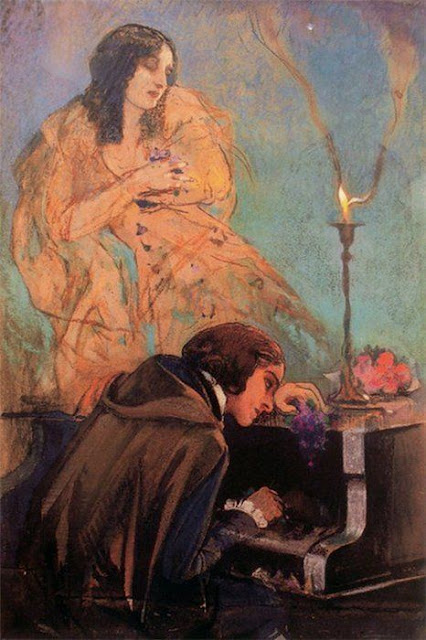Classical artists tend to use vertical and horizontal lines, right angles, and bright colors
(especially blue skies).
The outlines of their figures are sharp and clear-cut.
They tend towards less decoration, less busy works.
Romantic artists prefer diagonal lines, circles, bends and swirls. Also darker colors and
The outlines of their figures are sharp and clear-cut.
They tend towards less decoration, less busy works.
Romantic artists prefer diagonal lines, circles, bends and swirls. Also darker colors and
foggy or stormy skies (and oceans).
They use less-distinct, often smudged or blurred outlines for the figures.
More decoration and often busier (more complex) works.
Roman Art - c. 100 - 250 (Classical)
Hellenistic Art (c. 350 - 30 BCE) (Romantic)
Drama, death, fantasy
Romanesque / Byzantine c. 1000 - 1200 (Classical)
Gothic Art - 1150 - 1400 (Romantic)
Characteristics: Emotional, Magical, Mysterious, Fantastical, Dramatic
Mysterious, spooky, imagination, fantasy.
High Renaissance Art - c. 1500 (Classical)
Giovanni Pico della Mirandola - Oration on the Dignity of Man (1486)
Raphael - The School of Athens - 1509 - 1511
(Raphael's homage to the ancient Greek philosophers with Plato and Aristotle in the back center of the painting.)
Classical Architecture (Strong, with only moderate ornamentation)
Baroque Art - c. 1600 (Romantic)
Baroque art's romanticism includes (motion) action, drama, passion, anguish, foreboding, turbulence, chaos, tragic charter flaws, the mysterious and the magical. Greek mythology is a recurrent theme.
Gian Lorenzo Bernini - David - 1623 - 1624
Action, drama, tension, stress
Foreboding, apprehension, gloom
Action, Drama, Fear, Character Flaws
(Judas's betrayal of God for 30 pieces of silver)
Turbulence, Chaos, Destruction
Palace of Versailles
Ceiling of Ottobeuren Abbey in Bavaria (1711–1725)
19th Century Romantic Art - c. 1800 - 1850
Caspar David Friedrich - German
Théodore Géricault - French
Eugene Delacroix - French
Gustav Courbet - French

J.M.W. Turner - English
Thomas Cole - American
They use less-distinct, often smudged or blurred outlines for the figures.
More decoration and often busier (more complex) works.
Roman Art - c. 100 - 250 (Classical)
Emperor Augustus Caesar (63 B.C. - 14 A.D)
Calm, confident, courageous, moral, a virtuous leader of his people.
Hellenistic Art (c. 350 - 30 BCE) (Romantic)
Drama, death, fantasy
Romanesque / Byzantine c. 1000 - 1200 (Classical)
Hagia Sophia, Istanbul, 1261
Calm, confident, courageous, moral, a virtuous leader of his people.
Gothic Art - 1150 - 1400 (Romantic)
Characteristics: Emotional, Magical, Mysterious, Fantastical, Dramatic
Mysterious, spooky, imagination, fantasy.
Simone Martini (b. 1284)
High Renaissance Art - c. 1500 (Classical)
Giovanni Pico della Mirandola - Oration on the Dignity of Man (1486)
Michelangelo - David - 1501 - 1504
Calm, confident, courageous, moral, a virtuous leader of his people (same as Augustus Caesar, above).
Albrecht Dürer - Self Portrait - 1500
Focus on philosophers of classical antiquity (intellect), balance.
(Raphael's homage to the ancient Greek philosophers with Plato and Aristotle in the back center of the painting.)
Classical Architecture (Strong, with only moderate ornamentation)
Baroque Art - c. 1600 (Romantic)
Baroque art's romanticism includes (motion) action, drama, passion, anguish, foreboding, turbulence, chaos, tragic charter flaws, the mysterious and the magical. Greek mythology is a recurrent theme.
Baroque Art
Gian Lorenzo Bernini - David - 1623 - 1624
Action, drama, tension, stress
El Greco - View of Toledo - c. 1599
Foreboding, apprehension, gloom
Caravaggio - The Taking of Christ - 1602
Action, Drama, Fear, Character Flaws
(Judas's betrayal of God for 30 pieces of silver)
Peter Paul Rubens - The Fall of Phaeton - 1604
Turbulence, Chaos, Destruction
Baroque Architecture (c. 1680 - 1730)
Later Baroque architecture is busy, highly ornamental, complex, lush and often an overload of sensuality.
Complexity, sensuousness
Rococo Architecture (c. 1720 - 1760)
Rococo art softened Late Baroque art & architecture in color and with curvy lines. It depicted scenes of love, nature, amorous encounters, light-hearted entertainment, and youth. It was more light-hearted and frivolous than Baroque art and corresponds to galant style in music.
Ceiling of Ottobeuren Abbey in Bavaria (1711–1725)
J.S. Bach: Brandenberg Concerto No. 3 movement 3 (3:05) play
Busy, highly ornamental, complicated, sensual
Neoclassical Art - c. 1750 - 1800 - Simple, natural, stately, dignified, elegant
Ludwigsburg Palace Theater - Redesign after 1750
Brandenburg Gate, 1788 - 1791
Anton Raphael Mengs' Prince of Asturias (future Charles IV of Spain), c. 1765
Still, calm, poised, confident, intelligent
Still, calm, poised, confident, intelligent
Jacques-Louis David - The Death of Socrates (1787)
19th Century Romantic Art - c. 1800 - 1850
(Notice the similarities to early Baroque Art....)
Wanderer Above a Sea of Fog (1818)
The Raft of Medusa (1818)
Eugene Delacroix - French
Frederic Chopin & George Sand
Gustav Courbet - French

J.M.W. Turner - English
Dutch Boats in a Gale
Thomas Cole - American
William Blake - English
Elohim Creating Adam





























No comments:
Post a Comment